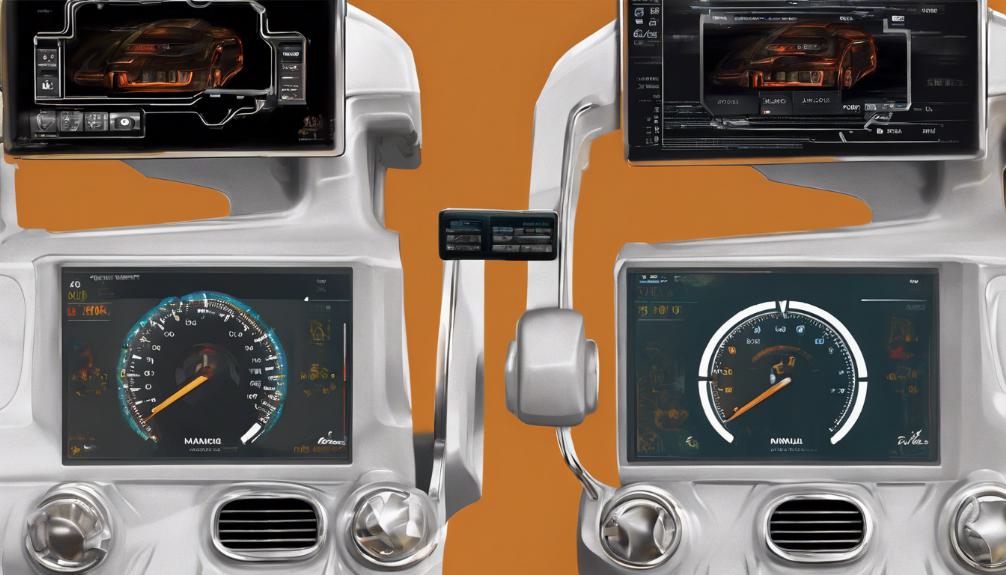Launch control manages engine RPM and boost pressure to optimize power buildup, preventing wheel spin, engine failures, and clutch issues.
It utilizes electronic controls and precise programming, working seamlessly with dual-clutch transmissions for efficient gear shifts.
Beneficial for competitive acceleration, this system maintains RPM for peak power in turbocharged engines. In racing, it offers an edge by fine-tuning acceleration and traction control for best starts and power delivery.
Tuning allows adjustment of rev limits based on throttle position and boost pressure, maximizing performance. Compared to manual launches, it enhances power output, manages torque effectively, and guarantees consistent acceleration.
Further information on fine-tuning and optimization awaits.
What You Need to Know
- Manages engine RPM and boost pressure for optimal power buildup.
- Prevents wheel spin, engine failures, and clutch issues during acceleration.
- Utilizes electronic controls and programming for consistent and controlled launches.
- Works seamlessly with dual-clutch transmissions for efficient gear shifts.
- Essential for competitive acceleration, maintaining peak power output for turbocharged engines.
How Launch Control Works

How does launch control optimize engine performance during acceleration?
Launch control systems are designed to manage engine RPM and boost pressure to achieve maximum power buildup while launching your vehicle.
By maintaining a preset RPM level, launch control helps prevent issues like spinning wheels, engine failures, and clutch problems commonly encountered during aggressive acceleration.
This system utilizes advanced engine management techniques, including electronic accelerator controls and computer programming, to make sure that the engine operates at peak efficiency during launch.
In addition to engine management, launch control often works in conjunction with dual-clutch transmissions to enable rapid and seamless gear shifts.
This integration allows for smoother acceleration and efficient power delivery to the wheels.
High-performance cars commonly feature launch control as a standard option, as it plays an important role in achieving competitive acceleration times.
By optimizing engine performance and managing boost pressure effectively, launch control enhances the overall driving experience, especially during high-speed launches and drag races.
Benefits of Launch Control
To fully appreciate the advantages of launch control, consider how this system optimizes acceleration and enhances overall driving performance.
Launch control acts as an electronic aid that helps in achieving competitive acceleration by maintaining the engine RPM at a set level for peak power buildup.
This feature is particularly essential for managing power delivery to the gearbox and wheels, especially in turbocharged engines where maintaining boost pressure is vital for peak performance.
By allowing manipulation of fuel and ignition settings, launch control enables drivers to achieve desired effects like backfires or flames during competitions.
Originally found in race cars, launch control has made its way into high-performance consumer vehicles, offering improved acceleration and driving experiences.
When paired with dual-clutch transmissions, launch control systems facilitate faster upshifts and efficient power delivery, resulting in smoother and more dynamic driving.
With the ability to finely tune ignition timing and control launch settings, launch control provides drivers with a competitive edge on the road or track.
Launch Control in Racing

In the world of racing, launch control serves as a critical tool for optimizing acceleration and gaining a competitive edge on the track.
When the race begins, launch control systems maintain engine RPM at an ideal level, allowing for efficient power buildup and consistent launches.
This precise control of engine output helps racing drivers achieve the perfect launch, propelling them ahead of the competition right from the start.
Furthermore, launch control systems work in conjunction with traction control to manage power delivery to the gearbox and wheels, preventing wheel spin and maximizing traction.
By carefully balancing power and grip, drivers can launch their vehicles with maximum efficiency, minimizing the risk of losing precious time due to wheelspin or loss of control.
Also, launch control is particularly advantageous for turbocharged engines, as it helps maintain boost pressure during takeoff, resulting in enhanced performance and quicker acceleration.
By utilizing features like the rev limiter and traction control, racing teams can fine-tune their launch control settings to achieve the best possible starts and gain a significant advantage on the track.
How does Launch Control Affect the Clutch Cycling Switch?
Launch control can have a significant impact on the clutch cycling switch location. The system’s ability to optimize launch performance by modulating engine power can affect the wear and tear on the clutch cycling switch. Understanding this interaction is crucial for maintaining the longevity of the clutch cycling switch location.
Tuning Launch Control
Adjusting the engine’s rev limit is vital when tuning launch control for peak performance on the track.
This process involves setting a specific RPM that the engine will hold during launches, allowing for consistent acceleration.
For vehicles like the Nissan GT-R with a sophisticated launch control system, tuning the launch rev limit is essential for optimizing power delivery.
By making adjustments to fuel and ignition cuts, you can achieve the desired launch RPM tailored to your driving needs.
Mapping the launch rev limit based on throttle position and boost pressure is essential, especially for turbocharged or supercharged engines.
Techniques such as retarding ignition timing can be employed for turbocharged engines paired with a clutch to enhance launch control performance.
Fine-tuning ignition maps is a key aspect of tuning launch control, ensuring that the engine outputs maximum power efficiently during launches.
Mastering these adjustments will help you maximize the full potential of your vehicle’s launch control system on the track.
Launch Control Vs. Manual Launch

Launch control outperforms manual launches by optimizing engine RPM and power delivery for consistent acceleration.
Manual launches, sometimes referred to as the traditional form of launch, require precise clutch control and throttle modulation.
In contrast, launch control acts as an aid to assist in managing torque output more effectively, minimizing wheel spin, and maximizing traction.
While manual launches heavily rely on the driver’s skill and experience, launch control automates this process, offering a more consistent and controlled acceleration experience.
This technological advancement enhances performance and efficiency compared to traditional manual launch techniques.
By automating the optimization of engine RPM and power delivery, launch control guarantees that the vehicle accelerates smoothly and efficiently, making it a valuable tool for achieving quick and repeatable launches.
As an Amazon Associate we earn from qualifying purchases.










